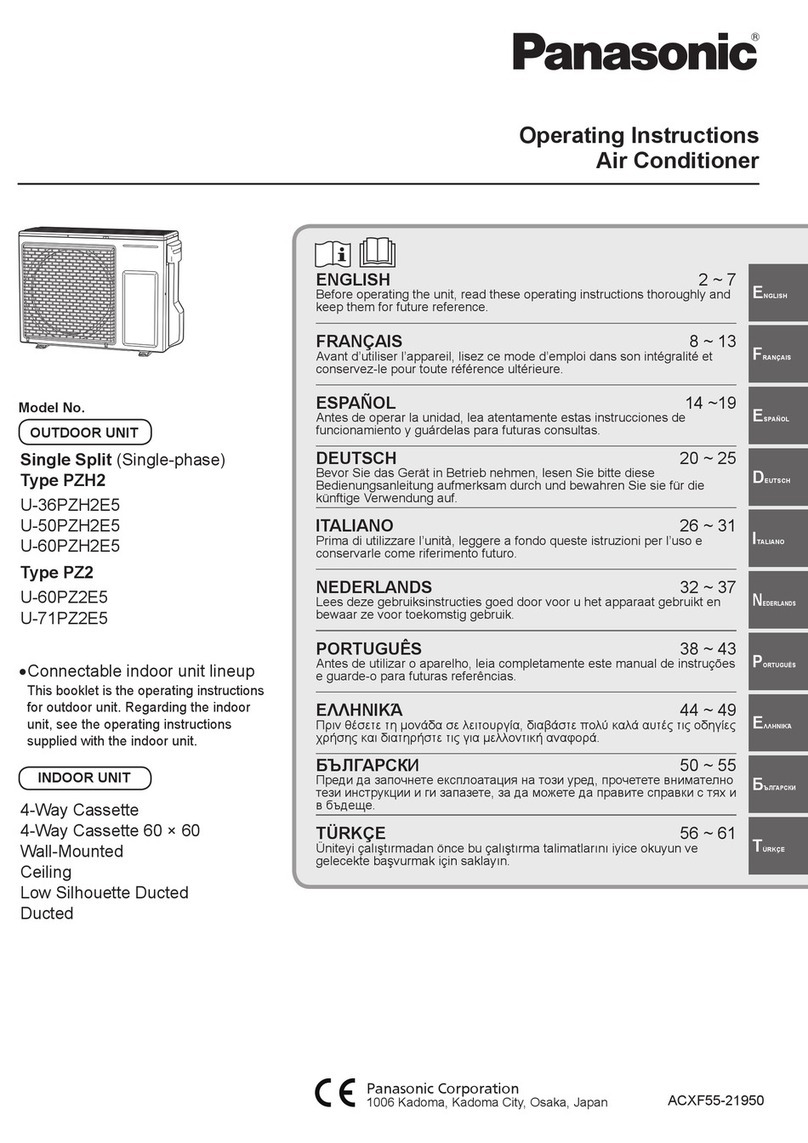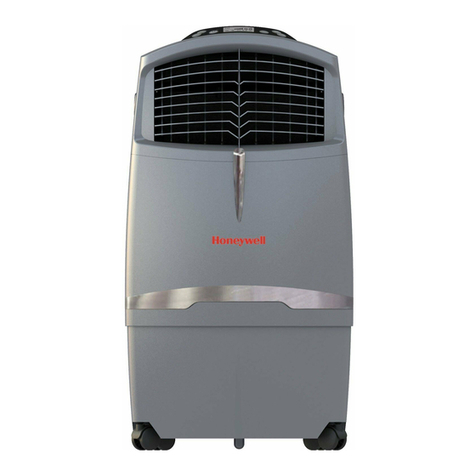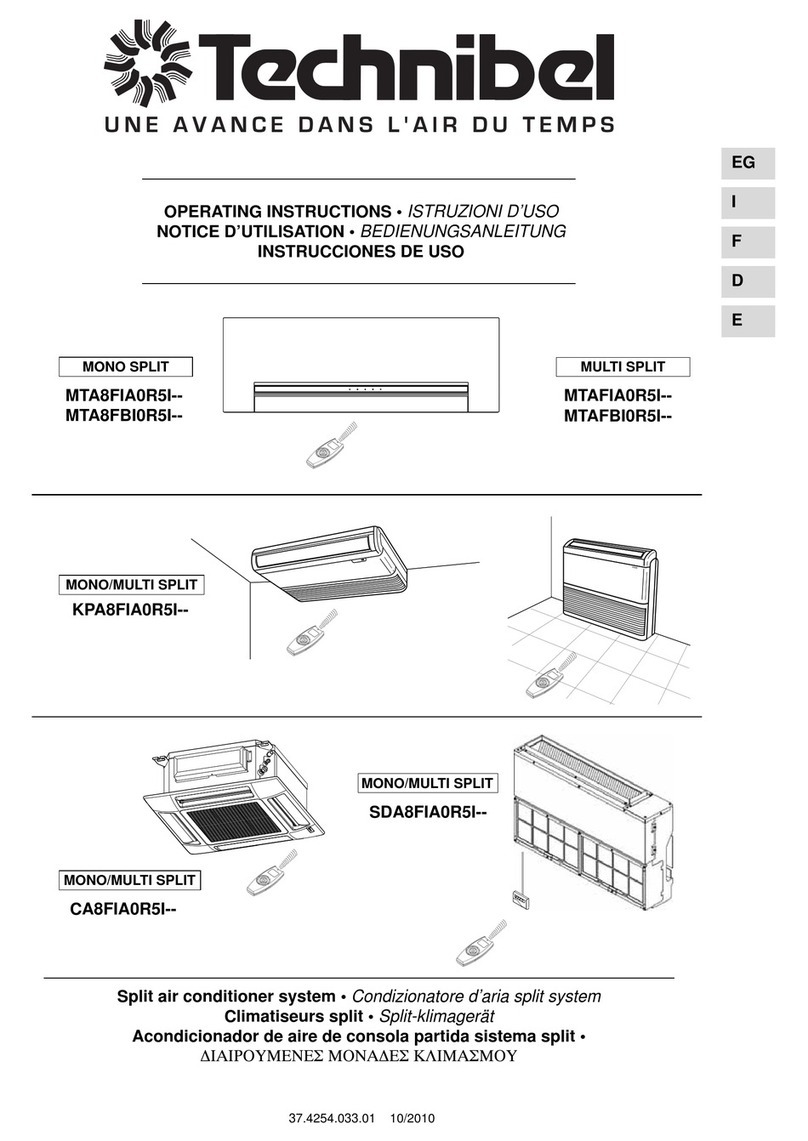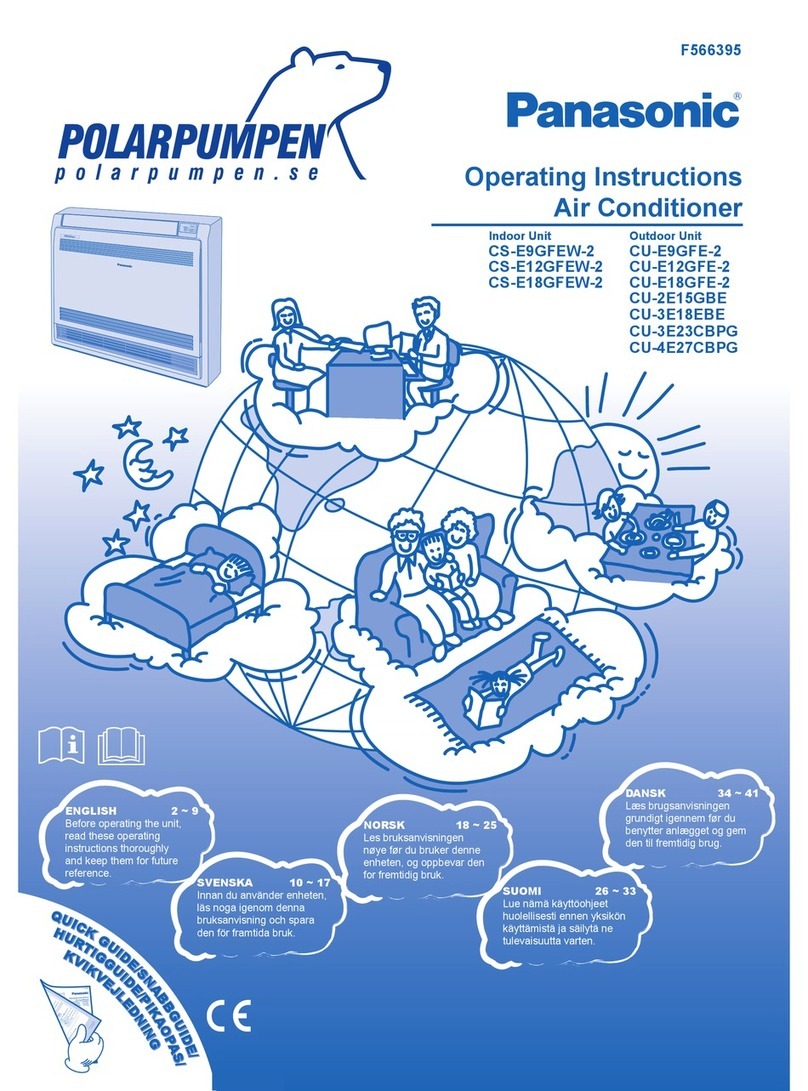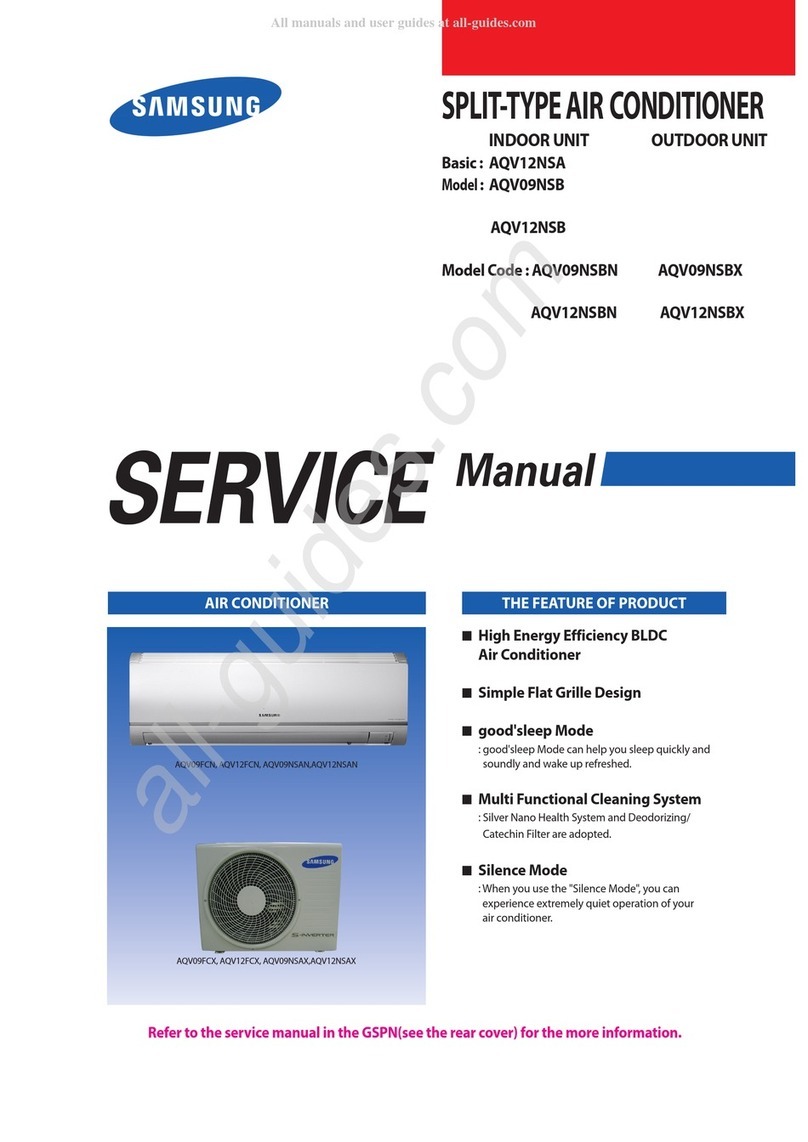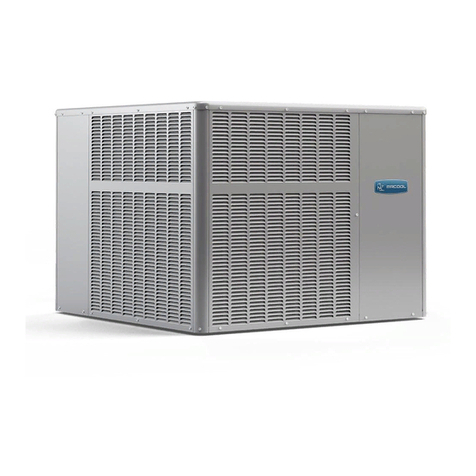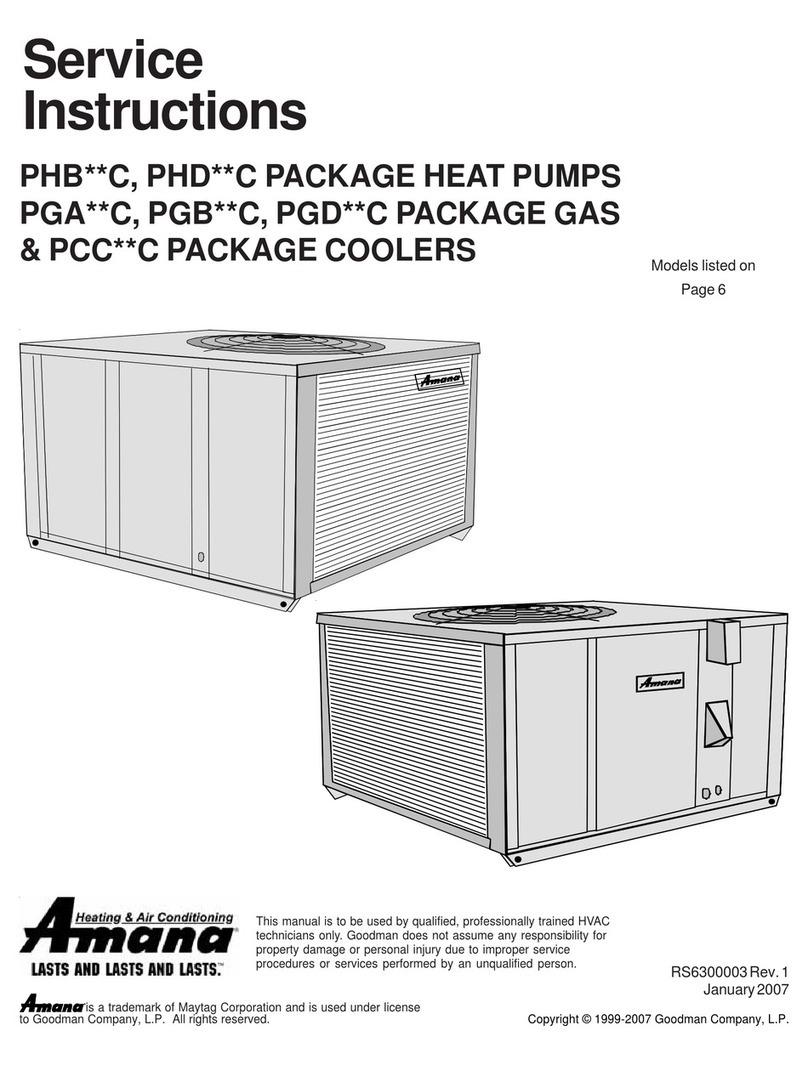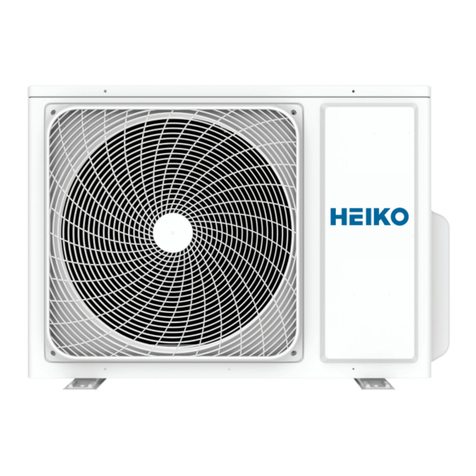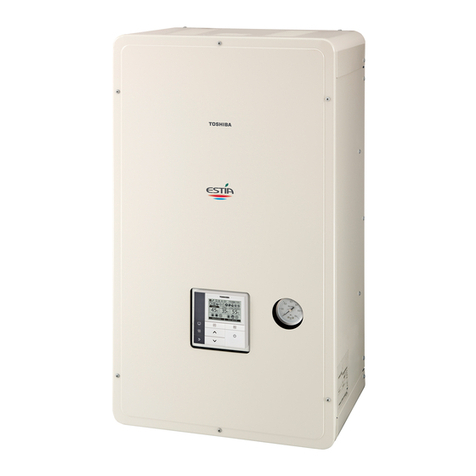Garrison 3554190 User manual

Owner’s Manual
INVERTER ONE-TWO/ONE-THREE/ONE-FOUR/ONE-FIVE SPLIT-TYPE AIR CONDITIONER
IMPORTANT NOTE:
Read this manual carefully before
installing or operating your new air
conditioning unit. Make sure to save
this manual for future reference.
This manual is only describes the outdoor
unit. When using the indoor unit,
refer to the user’s manual of the indoor unit.
•
•
Model: 3554190/3554191/3554192/3554193
3554194/3554195/3554196/3554197

Unit Parts and Major Functions ......................... 05
Manual Operation and Maintenance .............. 09
Table of Contents
Owner’s Manual
SAFETY
FIRST
Safety Precautions .................................................... 04
1
2
3

Page 3
Troubleshooting................................. 10
a. Common Problems ................................. 10
b. Troubleshooting Tips ............................... 11
European Disposal Guidelines.............................................................. 12
4
5

Page 4
Thank you for purchasing this air conditioner. This manual will provide you with information on how
to operate, maintain, and troubleshoot your air conditioner. Following the instructions will ensure the
proper function and extended lifespan of your unit.
Please pay attention to the following signs:
Safety Precautions 1
WARNING
• Ask an authorized dealer to install this air
conditioner. Inappropriate installation may
cause water leakage, electric shock, or fire.
• The warranty will be voided if the unit is not
installed by professionals.
• If abnormal situation arises (like burning
smell), turn o the power supply and call
your dealer for instructions to avoid electric
shock, fire, or injury.
• DO NOT
let the indoor unit or the remote
control get wet. It may cause electric shock
or fire.
• DO NOT
insert fingers, rods, or other
objects into the air inlet or outlet. This may
cause injury, since the fan may be rotating
at high speeds.
• DO NOT
use a flammable spray, such as
hairspray, lacquer, or paint, near the unit.
This may cause fire or combustion.
CAUTION
General
Introduction
• DO NOT touch the air outlet while the swing
flap is in motion. Fingers might get caught
or the unit may break down.
• DO NOT inspect the unit by yourself. Ask an
authorized dealer to perform the inspection.
•
To prevent product deterioration, do not use
the air conditioner for preservation purposes
(storage of food, plants, animals, works of
art, etc.).
Failure to observe a warning may result in death. The appliance must be
installed in accordance with national regulations.
.
Failure to observe a caution may result in injury or equipment damage.
WARNING
CAUTION
• DO NOT place items that might be aected
by moisture damage under the indoor unit.
Condensation can occur at a relative
humidity of 80%.
• DO NOT
expose heat-producing appliances
to cold air or place them under the indoor
unit. This may cause incomplete combustion
or deformation of the unit due to the heat.
• After long periods of usage, check the
indoor unit to see if anything is damaged. If
the indoor unit is damaged, it may fall and
cause injury.
• If the air conditioner is used with other
heating devices, thoroughly ventilate
the room to avoid oxygen deficiency.
• DO NOT
climb onto or place objects on top
of the outdoor unit.
• DO NOT
operate the air conditioner when
using fumigant insecticides. The chemicals
may become layered with the unit and
endanger those who are hypersensitive to
chemicals.
• DO NOT
let children play with the air
conditioner.
•
The air conditioner can be used by children aged
8 years and older and people with reduced
physical, sensory, or mental capabilities, or lack
of experience and knowledge, if they have been
given instruction on how to properly and safely
operate the system.
• DO NOT
operate the air conditioner in a wet
room (e.g. bathroom or laundry room). This
can cause electric shock and cause the
product to deteriorate.
Safety
Precautions
• DO NOT operate the air conditioner with
wet hands. It may cause electric shock.
• DO NOT touch the evaporator coils inside
the indoor unit. The evaporator coils are
sharp and may cause injury.

Page 5
Unit Parts and Major Functions 2
Unit Parts
Fig. 2.1
Fig. 2.2
Unit Parts
And Major
Functions
Wall-mounted type Duct / Ceiling type
Indoor unit
1. Panel frame
2. Rear air intake grille
3. Front panel
4. Air purifying lter & air lter (rear)
5. Horizontal louver
6. LCD display window
7. Vertical louver
8. Manual control button (behind)
9. Remote controller holder
Outdoor unit
10. Drain hose and refrigerant connecting pipe
11. Connective cable
12. Stop valve
13. Fan hood
Indoor unit
1. Air outlet
2. Air inlet
3. Air lter
4. Electric control cabinet
5. Wire controller
Outdoor unit
6. Drain hose and refrigerant connecting pipe
7. Connective cable
8. Stop valve
9. Fan hood
Unit Parts
And Major
Functions

Fig. 2.3
Page 6
Unit Parts
And Major
Functions
Floor and standing type (console) Compact four-way cassette-type
Indoor unit
1. Airow louver (at air outlet)
2. Air inlet (with air lter in it)
3. Remote controller
4. Installation part
5. Display panel
Outdoor unit
6. Drain hose, refrigerant connecting pipe
7. Connective cable
8. Stop valve
9. Fan hood
Fig. 2.4
Indoor unit
1. Drain pump (drain water from indoor unit)
2. Drain hose
3. Air outlet
4. Air inlet
5. Air-in grill
6. Display panel
7. Remote controller
Outdoor unit
8. Refrigerant connecting pipe
9. Connective cable
10. Stop valve
11. Fan hood

Operating Conditions
Use the system in the following temperature for safe and eective operation. If the air conditioner is
used outside of the following conditions, it may malfunction or be less efficient.
COOL Mode HEAT mode DRY mode
Indoor
Temperature
17-32°C
(62-90°F)
0-30°C
(32-86°F)
17-32°C
(62-90°F)
Outdoor
Temperature
0-50°C
(32-122°F) -15-24°C
(5-76°F)
0-50°C
(32-122°F)
-15-50°C
(5-122°F)
(low temperature
cooling models)
Unit Parts
And Major
Functions
Page 7
Features
Protection of the air conditioner
Compressor protection
• The compressor can't restart for 3 minutes
after it stops.
Anti-cold air (Cooling and heating models
only)
• The unit is designed not to blow cold air on
HEAT mode, when the indoor heat exchanger
is in one of the following three situations and
the set temperature has not been reached.
A) When heating has just starting.
B) Defrosting.
C) Low temperature heating.
• The indoor or outdoor fan stops running when
defrosting (Cooling and heating models only).
Defrosting (Cooling and heating models only)
• Frost may be generated on the outdoor unit
during heat cycle when outdoor temperature is
low and humidity is high, resulting in lower
heating eciency of the air conditioner.
• During this condition, air conditioner will stop
heating operation and start defrosting
automatically.
• The time to defrost may vary between 4 to 10
minutes according to the outdoor temperature
and the amount of frost buildup on the
outdoor unit.
Auto-Restart (some models)
In case of power failure, the system will
immediately stop. When power returns, the
Operation light on the indoor unit will flash. To
restart the unit, press the ON/OFF button on the
remote control. If the system has an auto-restart
function, the unit will restart using the same
settings.
A white mist coming out from the indoor unit
• A white mist may generate due to a large
temperature dierence between air inlet and
air outlet on COOL mode in an indoor
environment that has a high relative humidity.
• A white mist may generate due to moisture
generated from defrosting process when the
air conditioner restarts in HEAT mode
after defrosting.
Low noise of the air conditioner
• You may hear a low hissing sound when the
compressor is running or has just stopped
running. This sound is the refrigerant
owing or coming to a stop.
• You can also hear a low "squeak" sound when
the compressor is running or has just stopped
running. This is caused by heat expansion and
cold contraction of the plastic parts in the unit
when the temperature is changing.
• A noise may be heard due to louver restoring
to its original position when power is rst
turned on.
Dust is blown out from the indoor unit.
This is a normal condition when the air conditioner
has not been used for a long time or during rst
use of the unit.
A peculiar smell comes out from the indoor unit.
This is caused by the indoor unit giving o smells
permeated from building materials, furniture,
or smoke.
NOTE: For multi-split-type air conditioners, one outdoor unit can match dierent types of indoor
units. Therefore, all the pictures in this manual are for explanation only. Your air conditioner may
be slightly dierent. The actual shape shall prevail.
The following pages introduce several kinds of indoor units matching with the outdoor units.

Unit Parts
And Major
Functions
Page 8
Energy-Saving Tips
• DO NOT
set the unit to excessive temperature levels.
• While cooling, close the curtains to keep out direct sunlight.
• Doors and windows should be kept closed to keep cool or warm air in the room.
•
DO NOT
place objects near the air inlet and outlet of the unit. This will reduce the efficiency of the unit.
• Set a timer and use the built-in SLEEP/ECONOMY mode if applicable.
• If you don’t plan to use the unit for a long time, remove the batteries from the remote control.
• Clean the air filter every two weeks. A dirty filter can reduce cooling or heating efficiency.
• Adjust louvers properly and avoid direct airflow.
The air conditioner turns to FAN only mode
from COOL or HEAT (for cooling and
heating models only) mode.
When indoor temperature reaches the
temperature setting on air conditioner, the
compressor will stop automatically, and the air
conditioner will turn to FAN only mode. The
compressor will start again when the indoor
temperature rises on COOL mode or falls on
HEAT mode (for cooling and heating models
only) to the set point.
Dripping water may mccumulate on the surface of
the indoor unit when cooling in areas with relatively
Adjust the horizontal louver to the maximum air
outlet position and select HIGH fan speed.
Heating mode (for cooling and heating
models only)
The air conditioner draws in heat from the
outdoor unit and releases it via the indoor unit
during heating operation. When the outdoor
temperature falls, heat drawn in by the air
conditioner decreases accordingly. At the same
time, heat loading of the air conditioner increases
due to larger dierence between indoor and
outdoor temperature. If a comfortable
temperature can't be achieved by the air
conditioner, we suggest you use a supplementary
heating device.
Lightning or a car wireless telephone operating
nearby may cause the unit to malfunction.
Disconnect the unit from the power source and
ON/OFF button on the remote controller to
restart operation.
Closing the curtains while heating also
helps keep the heat in
Doors and windows should be kept
closed
high humidity (relative humidity higher than 80%).
then reconnect it. Push the

Manual Operations
And Maintenance
Page 9
Manual Operations And Maintenance 3
Operation mode selection
Maintenance
While simultaneously operating two indoor units
or more, make sure the operation modes do not
conict with each other. The heat mode claims
precedence over all other modes. If the unit
intially started operates under heat mode, the
other units should operate under heat mode only.
For example: If the unit intially started operates
under cool (or fan) mode, the other units can
operate under any mode except heat. If one of
the units select heat mode, the other operating
units will stop operation and diplay ”--” (for the
units with display window only), or the Auto and
Operation indication light will ash rapidly, the
Defrost indication light will turn o, the Timer
indication light will remain on (for the units
without display window ), the Defrost and
Alarm indication lights (if applicable) will illuminate
and the Timer indication light will turn o (for the
If you plan to idle the unit for a long time,
perform the following:
1. Clean the indoor unit and air lter.
2. Select FAN only mode, let the indoor fan run
for a while to dry the inside of the unit.
3. Disconnect the power supply and remove
battery from the remote control.
4. Check components of the outdoor unit
periodically. Contact a local dealer or a
customer service centre if the unit requires
servicing.
When the air conditioner is to be used
again:
• Use a dry cloth to wipe o the dust
accumulated on rear air intake grille, in order to
avoid the dust blowing out from the indoor unit.
• Check that the wiring is not broken o or
disconnected.
• Check that the air lter is installed.
• Check if the air outlet or inlet isn't blocked after
the air conditioner has not been used for a long
time.
Suggestion: For the unit that adopts an Electric
Heater, when the outside ambient
temperature is below 0°C (32°F), we strongly
recommend keeping the machine plugged
in to guarantee it runs smoothly.
Optimal operation
To achieve optimal performance, please note the
following:
• Adjust the airow direction correctly so that it
is not directed at people.
• Adjust the temperature to achieve the highest
comfort level. Do not adjust the unit to
excessive temperature levels.
• Close doors and windows on COOL or HEAT
modes, or performance may be reduced.
• Use TIMER ON button on the remote controller
to select a time you want to start your air
conditioner.
• Do not put any object near air inlet or air
outlet, as the eciency of the air conditioner
may be reduced and the air conditioner may
stop running.
• Clean the air lter periodically, otherwise
cooling or heating performance may be
reduced.
• Do not operate unit with horizontal louver in
closed position.
NOTE: Before you clean the air conditioner, be
sure to switch the unit o and disconnect the
power supply plug.
or, the Operation indication light will ash rapidly
floor and standing types).

Page 10
Troubleshooting
CAUTIONS
If one of the following conditions occurs, switch o the power supply immediately and contact
your dealer for further assistance.
• The operation light continues to flash rapidly after the unit has been restarted.
• The remote control buttons do not work.
• The unit continually trips fuses or circuit breakers.
• A foreign object or water enters the air conditioner.
• The indoor unit leaks.
Common Problems
The following symptoms are not a malfunction and in most situations will not require repairs.
Problem Possible Causes
Unit does not
turn on when
pressing ON/
OFF button
The unit has a 3-minute protection feature that prevents the unit from
overloading. The unit cannot be restarted within three minutes of being
turned o.
Cooling and Heating Models: If the Operation light and PRE-DEF (Pre-heating/
Defrost) indicators light up, the outdoor temperature is too cold and the unit’s
anti-cold wind is activated in order to defrost the unit.
In Cooling-only Models: If the “Fan Only” indicator lights up, the outdoor
temperature is too cold and the unit’s anti-freeze protection is activated in
order to defrost the unit.
The unit changes
from COOL mode
to FAN mode
The unit changes its setting to prevent frost from forming. Once the
temperature increases, the unit will start operating again.
The set temperature has been reached, at which point the unit turns o the
compressor. The unit will resume operating when the temperature fluctuates
again.
The indoor unit
emits white mist
In humid regions, a large temperature dierence between the room’s air and
the conditioned air can cause white mist.
Both the indoor
and outdoor units
emit white mist
When the unit restarts in HEAT mode after defrosting, white mist may be
emitted due to moisture generated from the defrosting process.
The indoor unit
makes noises
A squeaking sound is heard when the system is OFF or in COOL mode. The
noise is also heard when the drain pump (optional) is in operation.
A squeaking sound may occur after running the unit in HEAT mode due to
expansion and contraction of the unit’s plastic parts.
Both the indoor
unit and outdoor
unit make noises
A low hissing sound may occur during operation. This is normal and is caused
by refrigerant gas flowing through the indoor and outdoor units.
A low hissing sound may be heard when the system starts, has just stopped
running, or is defrosting. This noise is normal and is caused by the refrigerant
gas stopping or changing direction.
The outdoor unit
makes noises The unit will make dierent sounds based on its current operating mode.
Troubleshooting 4

Page 11
Troubleshooting
Problem Possible Causes
Dust is emitted from
either the indoor or
outdoor unit
The unit may accumulate dust during extended periods of non-use, which
will be emitted when the unit is turned on. This can be mitigated by covering
the unit during long periods of inactivity.
The unit emits a
bad odor
The unit may absorb odors from the environment (such as furniture, cooking,
cigarettes, etc.) which will be emitted during operations.
The unit’s filters have become moldy and should be cleaned.
The fan of the
outdoor unit
does not operate
During operation, the fan speed is controlled to optimize product operation.
Troubleshooting Tips
When troubles occur, please check the following points before contacting a repair company.
Problem Possible Causes Solution
The unit
is not
working
Power failure Wait for the power to be restored
The power switch is o Turn on the power
The fuse is burned out Replace the fuse
Remote control batteries are dead Replace the remote control batteries
The unit’s 3-minute protection has
been activated Wait three minutes after restarting the unit
Poor cooling
performance
Temperature setting may be higher
than the ambient room temperature Lower the temperature setting
The heat exchanger on the indoor
or outdoor unit is dirty Clean the aected heat exchanger
The air filter is dirty Remove the filter and clean it according
to instructions
The air inlet or outlet of either unit
is blocked
Turn the unit o, remove the obstruction,
and turn it back on
Doors and windows are open Make sure that all doors and windows are
closed while operating the unit
Excessive heat is generated by
sunlight
Close windows and curtains during
periods of high heat or bright sunshine
Low refrigerant due to leak or
long-term use
Check for leaks, reseal if necessary, and
top o refrigerant
The unit
starts and
stops
frequently
There’s too much or too little
refrigerant in the system
Check for leaks and recharge the system
with refrigerant
There is air, incompressible gas, or
foreign material in the refrigeration
system.
Evacuate and recharge the system with
refrigerant
System circuit is blocked Determine which circuit is blocked and replace
the malfunctioning piece of equipment
The compressor is broken Replace the compressor
The voltage is too high or too low Install a manostat to regulate the voltage
Poor heating
performance
The outdoor temperature is lower
than 7°C (44.5°F)
Check for leaks and recharge the system
with refrigerant
Cold air is entering through doors
and windows
Make sure that all doors and windows are
closed during use
Low refrigerant due to leak or
long-term use
Check for leaks, reseal if necessary, and
top o refrigerant

Page 12
European Disposal
Guidelines
European Disposal Guidelines 5
Users in Europe may be required to properly dispose of this unit. This appliance contains
refrigerant and other potentially hazardous materials. When disposing of this appliance, the law
requires special collection and treatment.
DO NOT
dispose of this product as household waste or
unsorted municipal waste.
When disposing of this appliance, you have the following options:
• Dispose of the appliance at designated municipal electronic waste collection facility.
• When buying a new appliance, the retailer will take back the old appliance free of charge.
• The manufacturer will also take back the old appliance free of charge.
• Sell the appliance to certified scrap metal dealers.
NOTE: Disposing of this appliance in the forest or other natural surroundings endangers your health
and is bad for the environment. Hazardous substances may leak into the groundwater and enter
the food chain.

Page 13
QSBPTYU-041AEN
16122300A05346
The design and specications are subject to change without prior notice for product
improvement. Consult with the sales agency or manufacturer for details.

Page 14

Page 15

Page 6

Page 7

Page 8
This manual suits for next models
7
Table of contents
Other Garrison Air Conditioner manuals
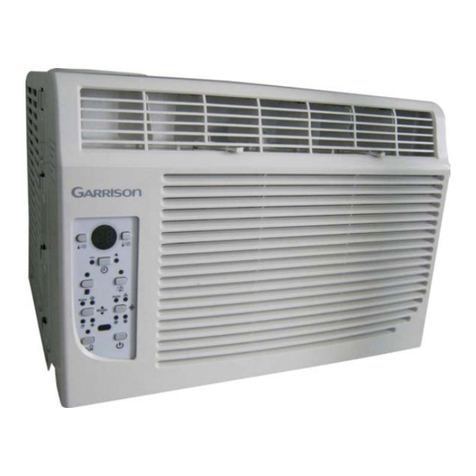
Garrison
Garrison 043-5488-8 User manual

Garrison
Garrison 2477821 User manual
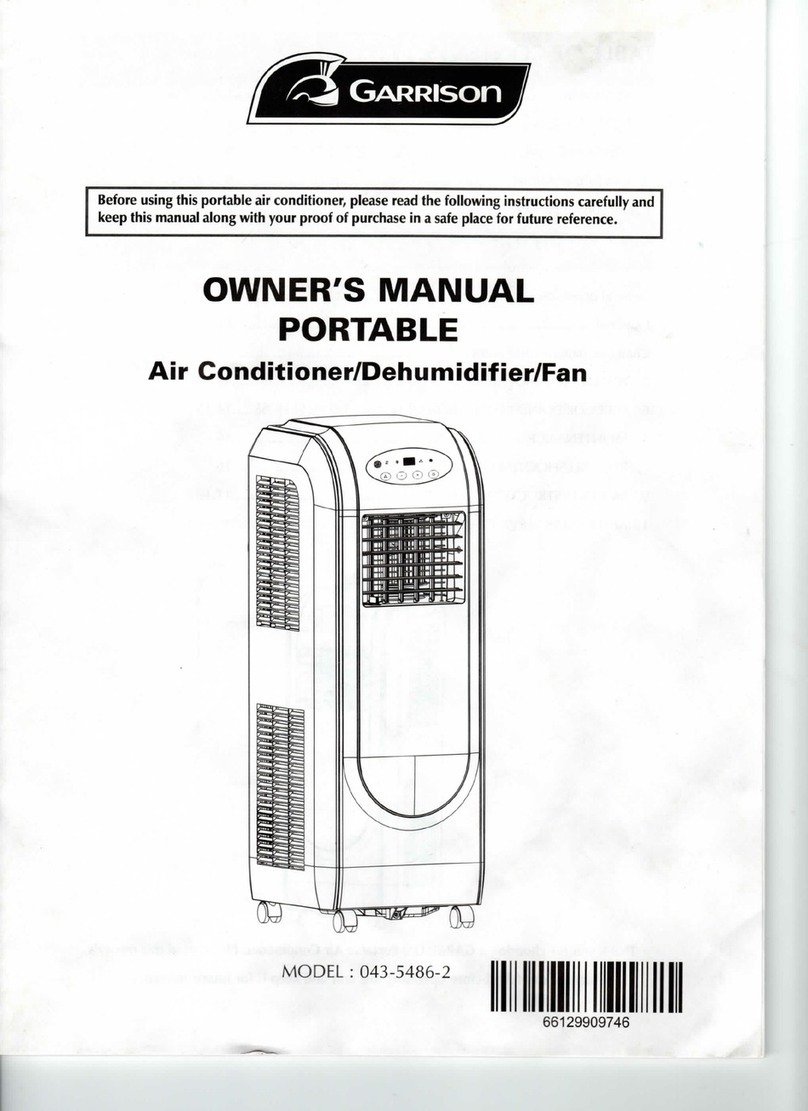
Garrison
Garrison 043-5486-2 User manual
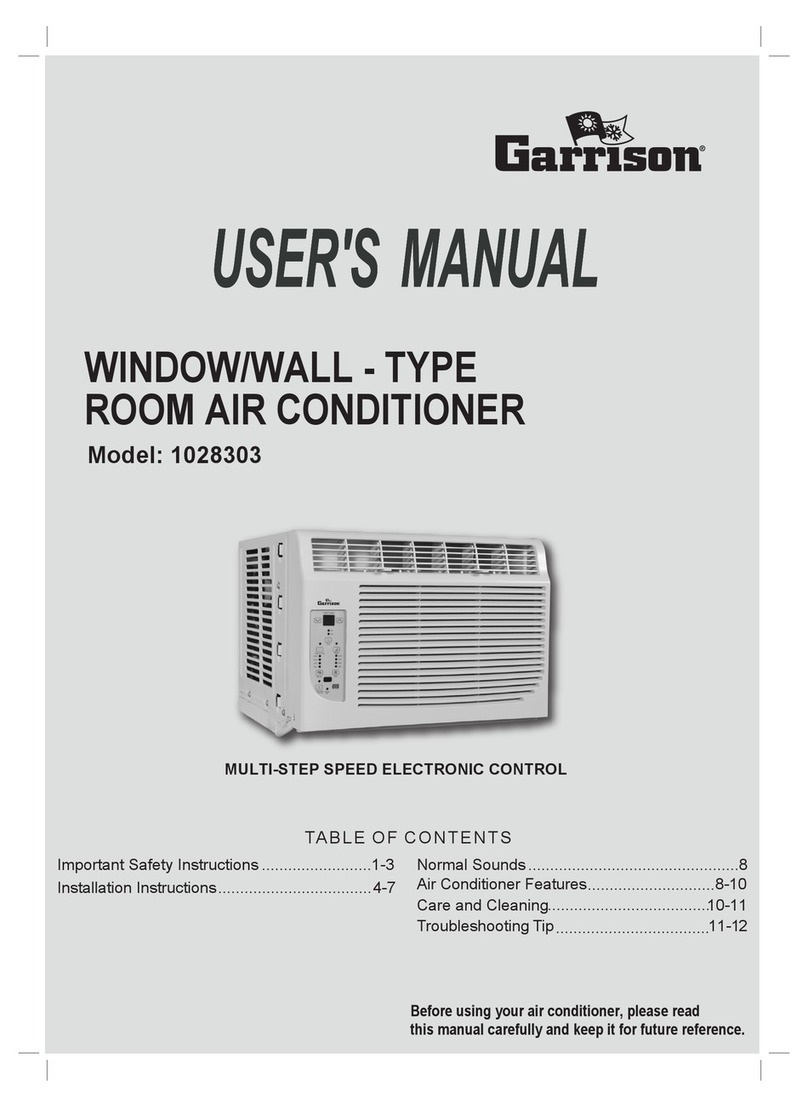
Garrison
Garrison 1028303 User manual
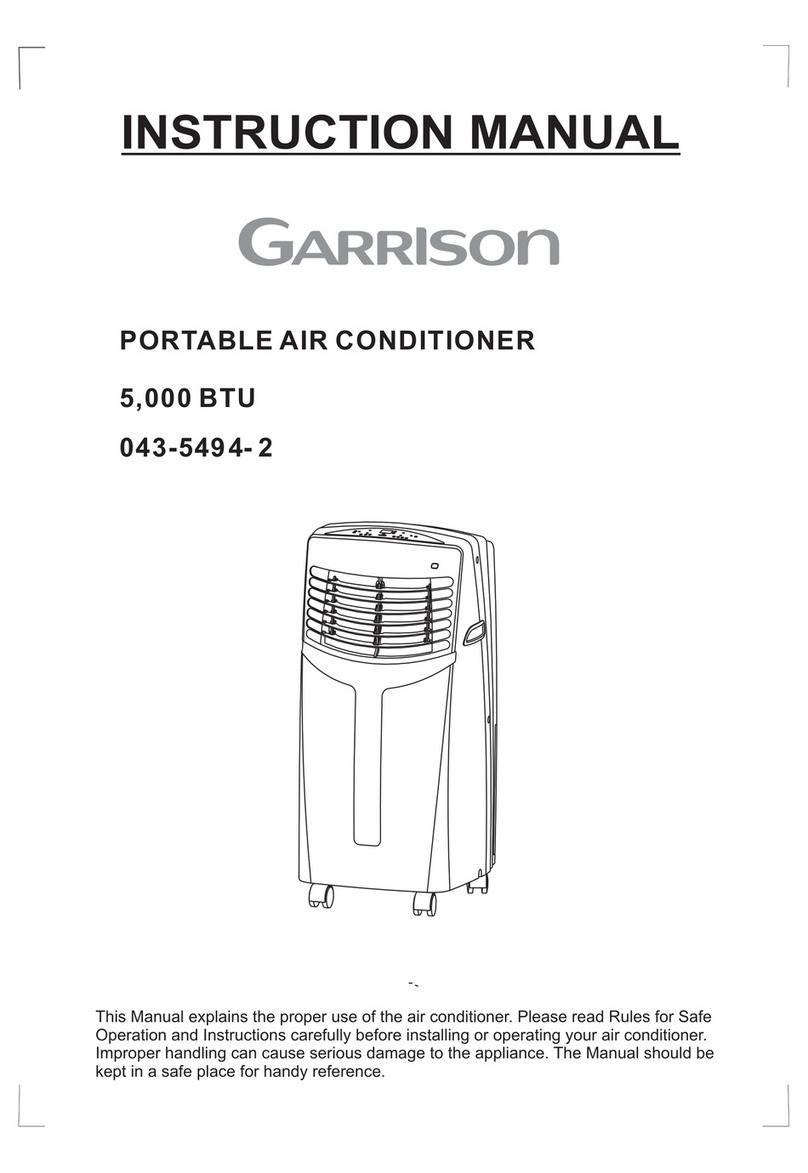
Garrison
Garrison 043-5494-2 User manual
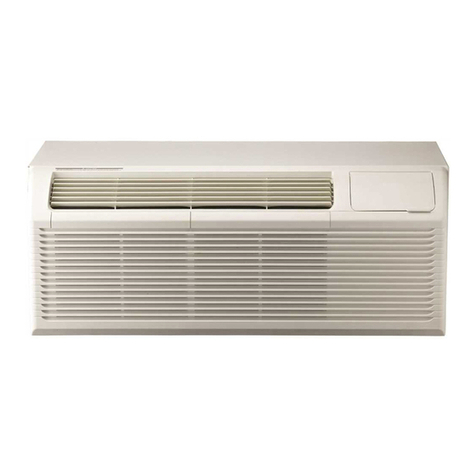
Garrison
Garrison 311410571 User manual
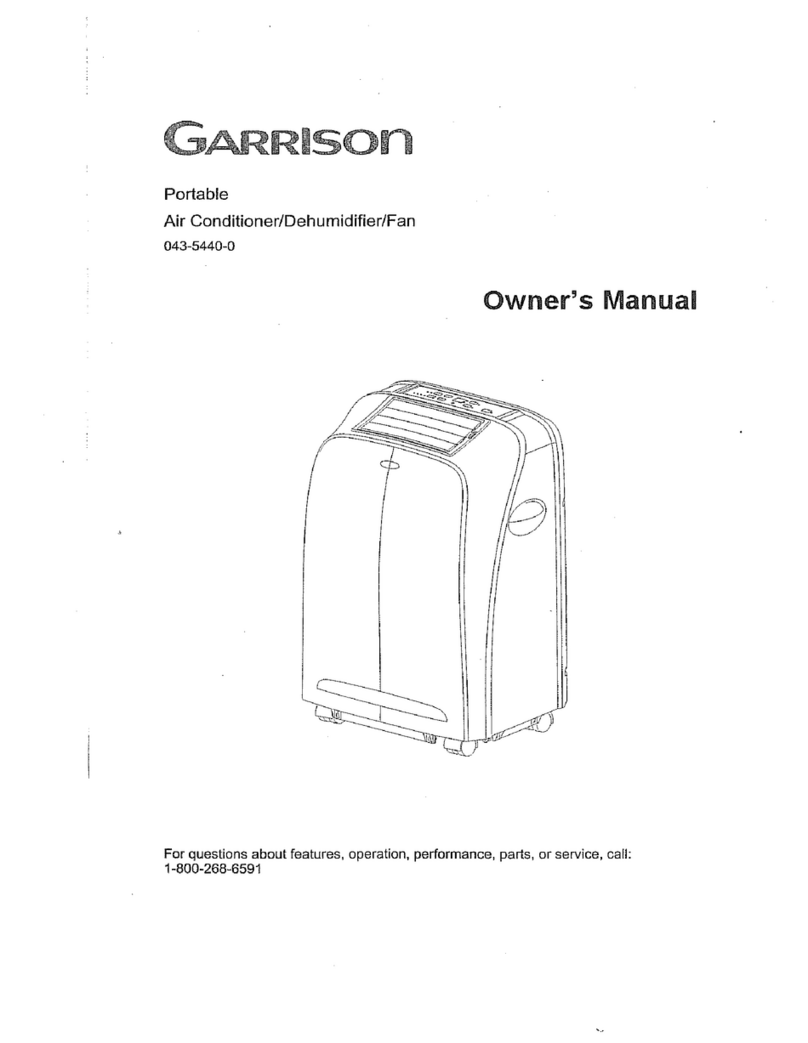
Garrison
Garrison 5440 User manual
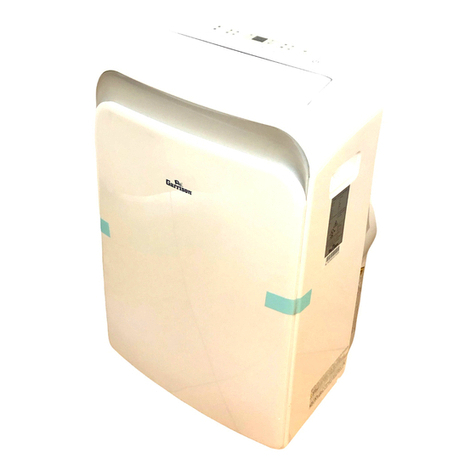
Garrison
Garrison 311438113 User manual
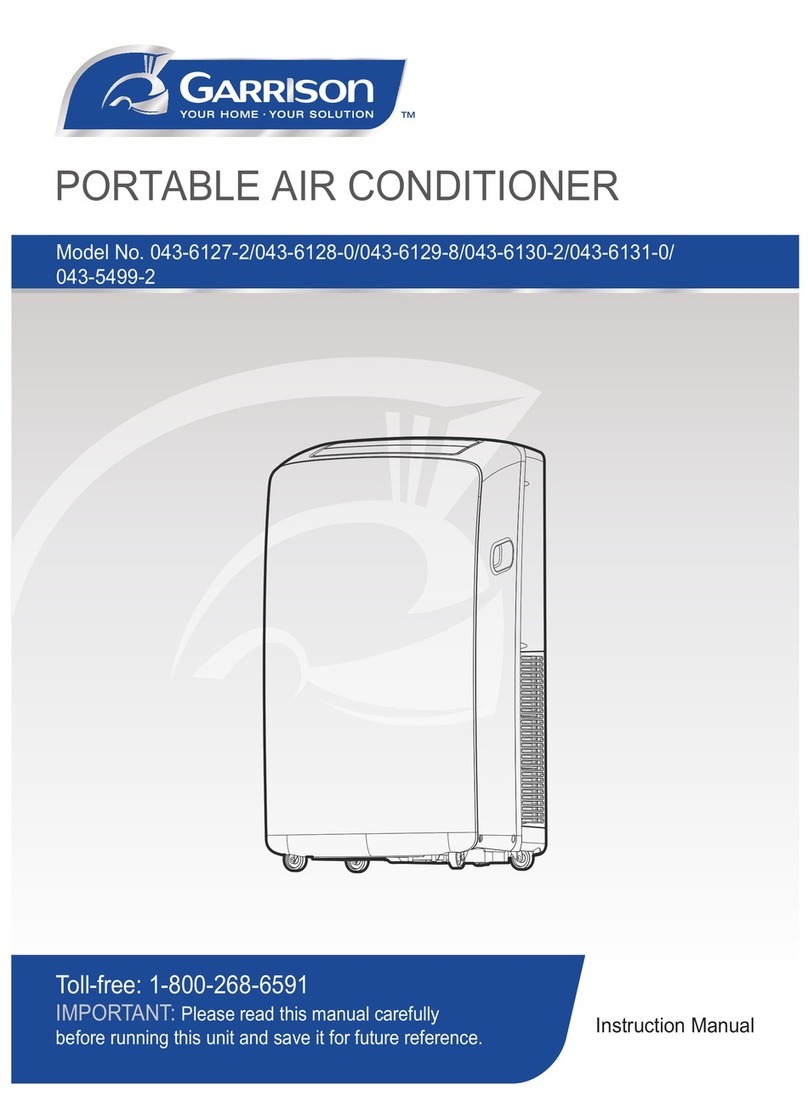
Garrison
Garrison 043-6127-2 User manual



